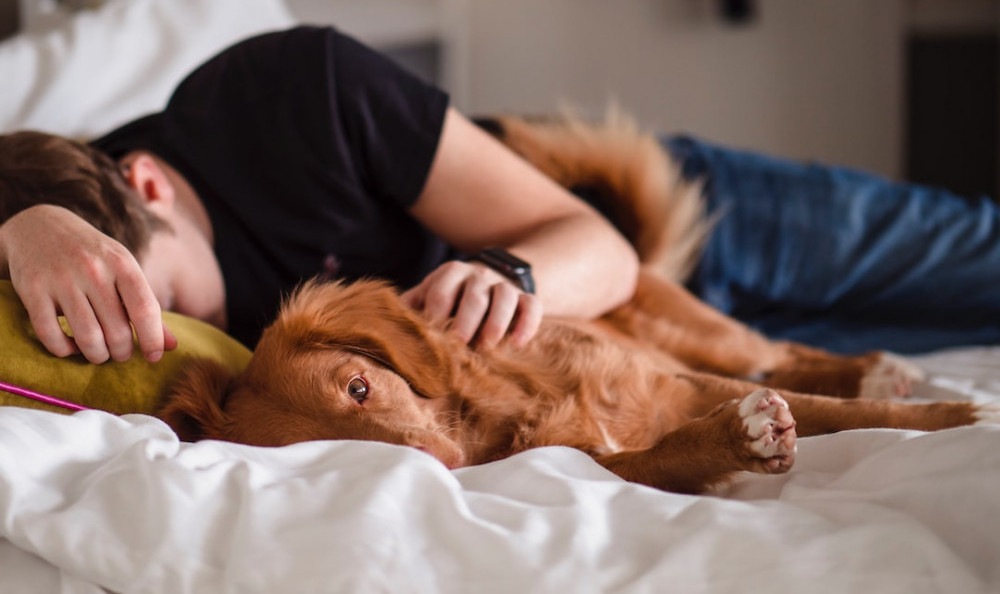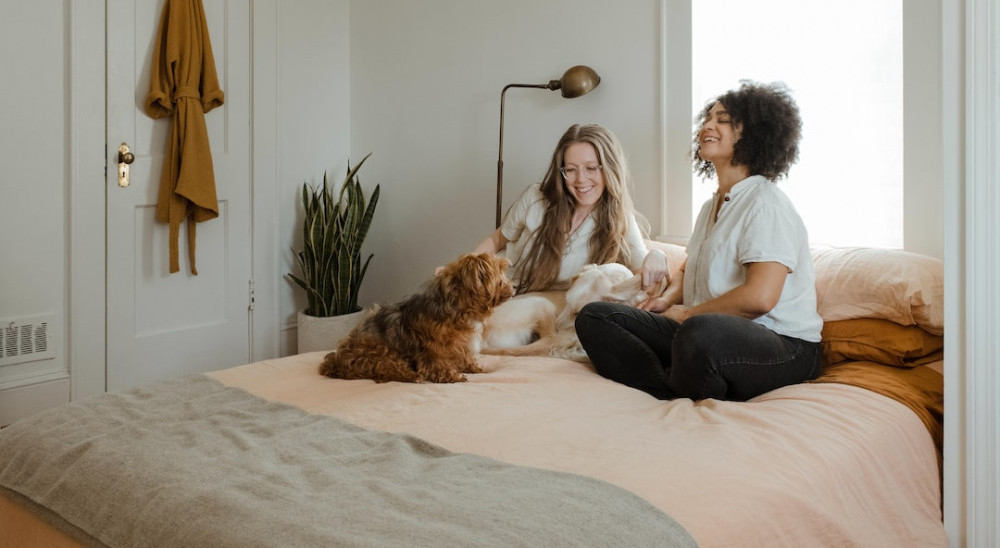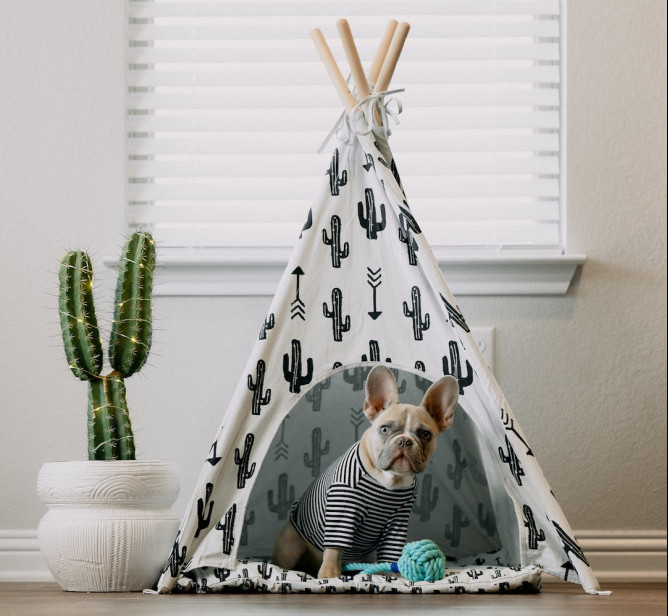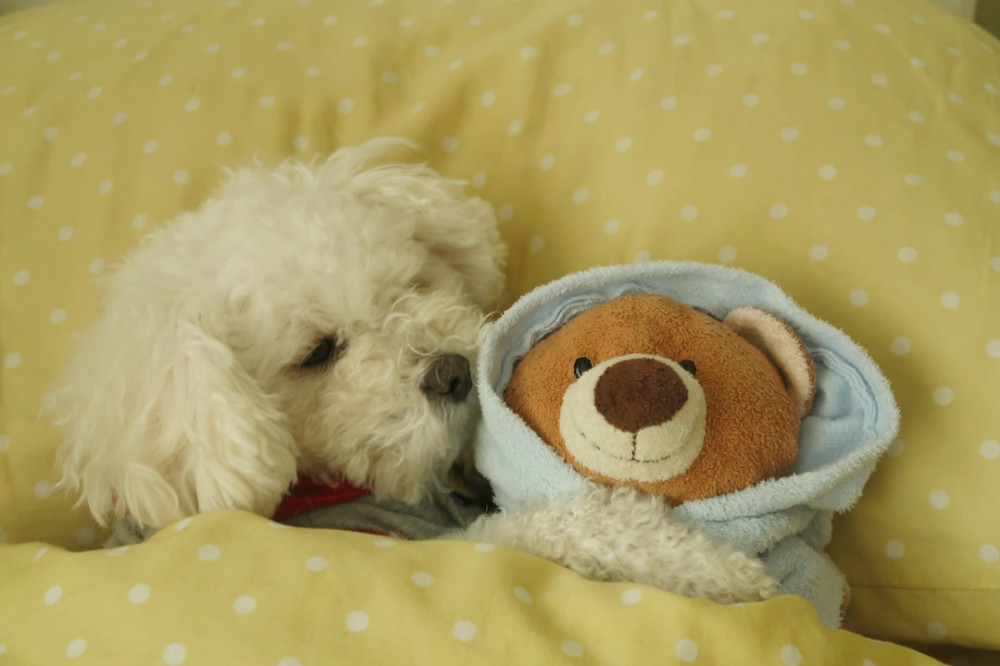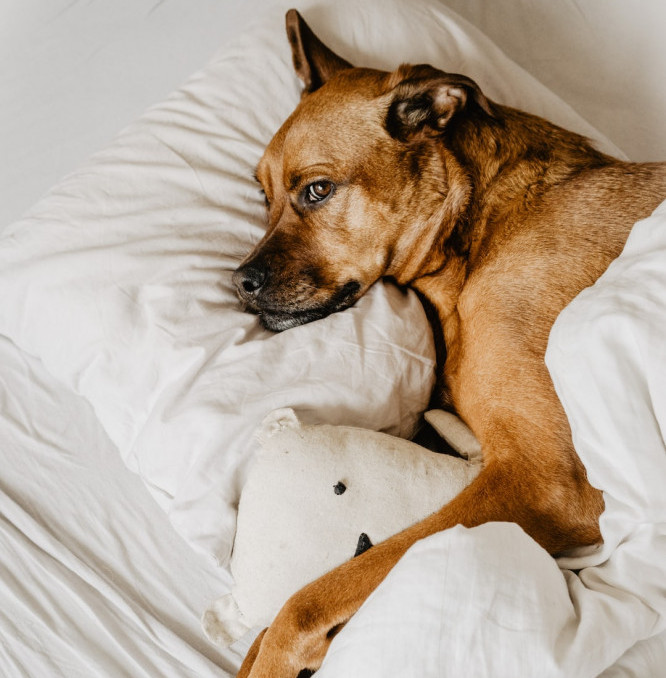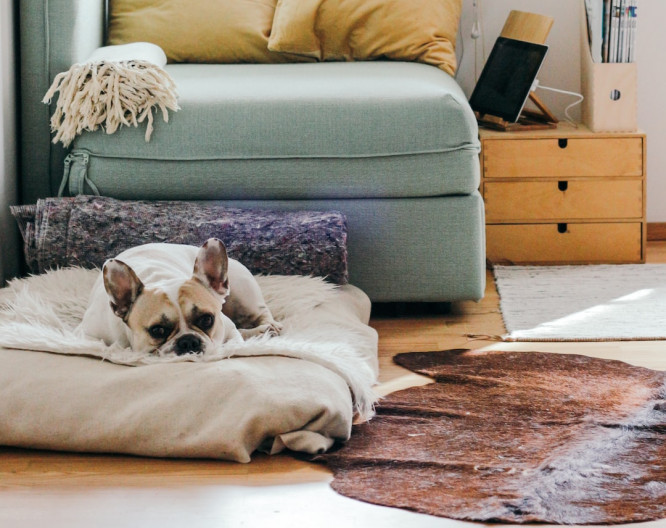It’s the end of a long day, and you’ve finally settled into your cozy bed, ready to enjoy a restful night’s sleep. But as you turn off the bedside lamp and close your eyes, you hear a familiar, rhythmic sound—a soft, contented snore.
You glance to your side and find your loyal furry friend, your canine companion, nestled beside you. It’s a scene that plays out in countless households around the world.
The question whether or not to let your dog sleep in your bed is one that many dog owners grapple with.
On one hand, it’s an endearing display of companionship, warmth, and trust. On the other, there are valid concerns about hygiene, behavior, and sleep quality.
It’s a topic that sparks debates, generates heartwarming stories, and even raises the occasional eyebrow.
In this article, we’ll delve into the heart of the matter, exploring the pros and cons of allowing your four-legged family member to share your sleeping space.
We’ll provide insights, expert opinions, and practical advice to help you make an informed decision that suits both your lifestyle and your beloved dog’s well-being.
If you have already made your decision to let the dog in, you can check out my suggestion for a dog blanket here. Or maybe you want a quality night’s rest for both of you, then see my suggestion for a dog bed here.
So, should you let your dog sleep in your bed? Let’s embark on this journey and find out together.
You Should Let Your Dog Sleep in Your Bed Because of:
Companionship
When you decide to share your bed with your dog, after a long and tiring day at work, for instance, you’re inviting a deeper level of companionship into your life. It’s not just about having them nearby during the night; it’s about inviting them into your personal space and daily routines.
For many, this companionship translates into an immeasurable comfort, reducing feelings of loneliness and anxiety. Your dog becomes your bedtime confidant, always there to lend an understanding ear or offer a reassuring nuzzle when you need it most.
The simple act of feeling their warmth and hearing their rhythmic breathing can be incredibly soothing, creating a sense of security that transcends words.
The emotional and psychological benefits of having your dog sleep in your bed create a strong bond. This close companionship also instills a sense of security that is truly invaluable, enriching both your life and your furry friend’s in ways that go beyond mere words.
In a world where busy schedules and daily stressors can make us feel isolated, the companionship of a dog at bedtime can be a profound source of solace. Your dog becomes a source of emotional support.
Warmth and Security
One of the most immediate and tangible benefits of letting your dog sleep in your bed is the warmth they bring.
Dogs are naturally warm-blooded animals, and their body heat can be incredibly comforting during the night. As they snuggle up beside you or curl up at your feet, you can feel their gentle warmth radiating, creating a cosy and calming environment.
It’s a choice that brings solace and connection, making the decision to let your dog sleep in your bed a heartwarming one for both you and your furry friend.
However, it’s not just physical warmth. The sense of security they provide is also the advantage for which people choose to let their pets into their beds.
Dogs have protective instincts ingrained in their nature. When they’re in your bed, they often take on the role of guarding you while you sleep. Their presence can make you feel safer and more relaxed.
The knowledge that your faithful companion is there, alert and ready to react to any unexpected sounds or movements, can provide peace of mind and contribute to a deeper, more restful sleep.
It’s like having a loyal guardian by your side, ensuring you’re protected and secure throughout the night.
Bonding
Allowing your dog to sleep in your bed can be a powerful way to strengthen the bond between you and your furry companion.
A deeper connection is created through physical closeness, emotional connection, trust and security.
Sharing your bed naturally brings you physically closer to your dog. The warmth and comfort of your shared sleeping space create a unique opportunity for physical bonding.
Bedtime is often a quiet, intimate time when you and your dog can relax without distractions. This tranquil environment encourages emotional bonding. Your dog may seek comfort, security, and a sense of belonging by sleeping close to you, and in turn, you experience a deep sense of attachment and care for your pet.
Allowing your dog in your bed can be seen as a sign of trust and acceptance. It signifies to your dog that they are an essential part of your life. This trust and security can lead to a stronger and more loyal bond.
Therapeutic Benefits
While dogs are not therapists, their presence can have therapeutic effects.
Studies have shown that being in the presence of a beloved pet can lower stress levels, reduce anxiety, and even improve mental health. It’s not just a subjective feeling; there’s scientific evidence to support the positive effects which you can read here.
Various studies have examined the psychological and physiological benefits of interacting with dogs, including reduced heart rate and lower cortisol levels, a hormone associated with stress.
The physical closeness and non-verbal reassurance your dog provides can be a powerful tool for managing the stresses of daily life.
The gentle rise and fall of their chest as they slumber beside you can be a tranquil lullaby, easing the weight of the world from your shoulders. It’s like a natural stress-relief mechanism built right into your nightly routine.
Interacting with your dog, especially during quiet moments like bedtime, can trigger the release of endorphins, which are natural mood elevators. These endorphins help counteract the effects of stress hormones, leading to a calmer and more relaxed state of mind.
The bond with your dog and the soothing routine of bedtime with them can serve as a valuable form of natural therapy, enhancing your overall well-being.
If you have already decided to bond with your dog and have warmth and security in your bed, you may want to consider a nice blanket for your companion. To find out more, click here.
While sharing your bed with your dog can be a wonderful way to bond, it’s not the right choice for everyone.
The choice of whether to let your dog sleep in your bed should be guided by what enhances the quality of your relationship and ensures a peaceful night’s sleep for both of you.
Cons of Letting Your Dog Sleep in Your Bed
In case you want more comfort for both, your dog and yourself, you can check out my suggestion for a dog bed here.
Hygiene Concerns
While the emotional and bonding aspects of sharing your bed with your dog are undeniable, there are important hygiene concerns to consider.
For individuals with allergies or asthma, allowing your dog in your bed can exacerbate these conditions. Pet dander, saliva, and fur can become embedded in your bedding, leading to allergic reactions and breathing difficulties.
Dogs, no matter how clean they are, can introduce dirt, mud, and other debris into your bed. Maintaining a clean and hygienic sleeping environment becomes more challenging when you share your bed with your pet.
Frequent washing of bedding and vacuuming becomes essential to keep your sleeping area free from dirt and allergens.
In addition to the previously mentioned hygiene concerns, shedding is another significant factor to consider when allowing your dog to sleep in your bed. Depending on your dog’s breed and the level of shedding, it may require extra effort to keep your sleeping area clean and free from fur.
Behavioral Problems
It’s essential to be aware of potential behavioral problems that may arise from sharing your bed area with your pet. These issues can range from dominance and territorial behavior to separation anxiety and training challenges.
Allowing your dog to sleep in your bed can sometimes reinforce dominant behavior, as dogs are pack animals with a hierarchical social structure. Your bed may be seen as a prime sleeping location, and some dogs may exhibit territorial behavior, which could lead to aggression or other behavioral problems.
Excessive attachment and separation anxiety when you’re not in bed is the next issue of the given situation. Your dog may become overly dependent on your presence, making it difficult for them to be comfortable and well-behaved when you’re not around.
If you have multiple dogs and allow one dog in your bed but not others, it can lead to jealousy and potential dog-on-dog aggression, as the dogs may compete for access to the bed.
Sleep Disruptions
It’s important to acknowledge the potential for sleep disruptions that may arise from this arrangement, too.
Some dogs are naturally restless sleepers. They may toss and turn, shift positions frequently, or even get up and down from the bed throughout the night. These actions can disturb your sleep and prevent you from achieving the deep, uninterrupted rest you need.
Just like humans, dogs can snore, and some breeds are more prone to it than others. If your dog snores, it can create a significant noise disturbance in your bedroom, making it challenging to fall asleep or stay asleep.
Depending on the size of your bed and your dog, space limitations can be an issue. Large dogs may take up a considerable portion of the bed, leaving you with less room to move and find a comfortable sleeping position.
Other causes that can lead to discomfort and night rest disruptions can also be temperature, allergies and hygiene.
Personal Preferences
Acknowledge that it ultimately depends on individual preferences and household dynamics
Certainly, personal preferences play a significant role in deciding whether to let your dog sleep in your bed.
Personal preferences regarding sleep comfort are a crucial consideration. Some people require a specific mattress type, pillow arrangement, or sleeping position to get a good night’s sleep. Allowing your dog in your bed may affect your sleep quality if their presence hinders your preferred sleeping conditions.
Personal preferences for a clean and tidy sleeping environment may clash with the realities of having a dog in your bed. Shedding, fur, dirt, and potential hygiene concerns may not align with your preference for a pristine sleeping space
Personal health considerations, such as allergies, can be a determining factor. If you or someone in your household has allergies to pet dander, sharing your bed with a dog may not align with your preference for an allergy-free sleeping environment.
Personal preferences for noise levels during sleep are important. Dogs can snore, whine, or make other noises during the night, which may disrupt your sleep if you have a low tolerance for nighttime sounds.
Dogs have their temperature preferences, and these may not align with your own. If you prefer a specific room temperature or bedding choices, your dog’s presence may affect your ability to maintain these preferences.
Personal preferences related to bed ownership are another factor. Some people have strong boundaries regarding personal space and may feel uncomfortable with the idea of their dog sharing their bed. They may prefer to maintain a clear distinction between human and pet sleeping areas.
The most critical personal preference is your sleep quality. If allowing your dog in your bed leads to sleep disruptions or discomfort that significantly impacts your sleep quality, it may clash with your preference for a good night’s rest.
Cultural or family norms can also influence personal preferences. Some cultures or families may have strong traditions regarding where pets should sleep, and these preferences can vary widely.
Personal preferences are highly subjective and play a central role in the decision of whether or not to let your dog sleep in your bed.
Your own sleep comfort, cleanliness standards, health considerations, noise tolerance, and temperature preferences are important factors to weigh against the benefits of sharing your bed with your dog.
It’s essential to make a decision that aligns with your personal preferences and promotes a healthy and restful sleep environment for you and your pet.
Tips for Making an Informed Decision
Prior to making a final decision, you should consider the following questions:
- Do you have specific sleep preferences or conditions that require a particular sleeping environment, such as mattress type, room temperature, or pillow arrangement?
- Do you or anyone in your household have allergies or asthma, and are you aware of the potential impact of pet dander on your health?
- What is your dog’s behaviour like during the night? Does your dog tend to be a restless sleeper, snore, or experience nighttime anxiety?
- How comfortable are you with sharing your personal sleeping space, and what are your comfort levels with noise, temperature, and cleanliness in your bedroom?
- How important is the quality of your sleep, and would sharing your bed with your dog potentially affect it positively or negatively?
- Are there any family or cultural norms that influence your decision regarding where your dog should sleep?
Here are some tips to help you with the decision:
- If you decide not to let your dog sleep in your bed, consider providing a comfortable dog bed in the bedroom or an adjacent room. Ensure it meets your dog’s needs and preferences.
- Establish clear boundaries and a designated sleeping area for your dog, which may include a crate or a specific part of the bedroom.
- Use positive reinforcement training techniques to encourage your dog to sleep in their designated area. Reward them for following your rules.
- Develop a soothing evening routine to help your dog wind down before bedtime, which may include a calming walk or playtime.
- If your dog exhibits signs of anxiety or restlessness at night, consult with a veterinarian for guidance on managing their behaviour.
- Monitor your dog’s response to any changes in sleeping arrangements and make adjustments as needed to ensure their comfort and well-being.
By asking these questions and considering alternative solutions, you can make an informed choice that benefits both you and your furry companion.
Conclusion
In the debate of whether to let your dog sleep in your bed, we’ve explored the pros and cons that come with this decision. It’s a choice that’s deeply personal and dependent on your unique circumstances and preferences.
Let’s recap the key points we’ve discussed.
On one hand, allowing your dog in your bed can lead to a stronger bond, provide comfort and companionship, and even offer therapeutic benefits by reducing stress and improving mental health. The gentle rise and fall of your dog’s chest can become a tranquil lullaby, easing the weight of the world from your shoulders.
On the other hand, there are valid concerns to consider. These include hygiene and potential allergens, shedding, the risk of sleep disruptions, and behavioural issues that may arise. Your own sleep preferences, health considerations, and need for a clean and peaceful sleeping environment are essential factors to weigh in your decision.
In the end, the choice is yours!
What matters most is ensuring that you and your furry companion have a loving and healthy relationship.
Whether you choose to share your bed or provide a comfortable, designated space nearby, your decision should reflect what aligns with your personal comfort, well-being, and family dynamics.
It’s crucial to establish boundaries, communicate your expectations, and use positive reinforcement to create a sleeping arrangement that fosters a harmonious coexistence.
Remember, there’s no one-size-fits-all answer to the question of whether your dog should sleep in your bed. The key is to make a decision that ensures both your restful nights and your dog’s well-being.
Ultimately, what matters most is the bond you share and the loving relationship that continues to thrive, whether in the shared warmth of your bed or in the comfort of a cosy dog bed nearby.
Additional Tips
– Just as humans have varying sleep habits, dogs do too. Some breeds are more inclined to be restless sleepers, while others are calmer at night. For example, a high-energy dog might be more prone to tossing and turning in bed, potentially leading to sleep disruptions.
A Labrador Retriever owner found that her dog’s bedtime restlessness often led to disrupted sleep. She eventually decided to provide a cosy dog bed in the same room to allow her and her furry friend to enjoy a restful night’s sleep.
– Regardless of your decision, positive reinforcement can be a valuable tool. Experts recommend using training techniques and rewards to encourage your dog to follow your desired sleeping arrangement. Reinforce the importance of designated sleeping spaces with praise and treats.
The opinion of a canine behaviourist expert: “Positive reinforcement is an effective way to establish sleeping boundaries. It reinforces good behaviour and encourages dogs to feel secure in their designated sleeping area.”
– The decision of whether to let your dog sleep in your bed can also involve family dynamics. It’s essential to consider the preferences of all family members and establish a consensus that works for everyone.
For example, you can keep your dog out of bed to maintain a healthy sleeping environment for the whole family. However, ensure your dog has a cosy bed in your bedroom to maintain emotional closeness.
– Dogs’ needs and habits can change, so staying flexible is key to maintaining a harmonious sleep environment.
Initially, your dog can struggle with sleeping alone, but over time, with your support they can enjoy restfull nights without feeling the need to share the bed.
If you have already made your decision to let the dog in, you can check out my suggestion for a dog blanket here. Maybe you want a quality night’s rest for both of you, then see my suggestion for a dog bed here.
Nevena’s Rescues requires all kinds of assistance. Please visit our Facebook page to see what help you can provide.

You may want to participate in auctions and donations to keep dogs safe and healthy until adoption.

